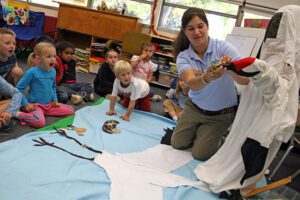Crane Trunk Activities
 Our educational Crane Trunks were designed to provide students with resources to understand concepts of Whooping Crane biology, ecology, conservation, captive breeding and reintroduction. The curriculum consists of a series of activities that are thoughtfully paired with hands-on learning tools, including a crane skull, flight diverters and a captive-rearing crane costume. These activities are a great tool to facilitate the learning process and are easily adapted for any age. Request a Crane Trunk for your classroom here.
Our educational Crane Trunks were designed to provide students with resources to understand concepts of Whooping Crane biology, ecology, conservation, captive breeding and reintroduction. The curriculum consists of a series of activities that are thoughtfully paired with hands-on learning tools, including a crane skull, flight diverters and a captive-rearing crane costume. These activities are a great tool to facilitate the learning process and are easily adapted for any age. Request a Crane Trunk for your classroom here.
Follow the links below to download PDF versions of the Crane Trunk manual and activities. If you need additional assistance, contact the Whooping Crane Outreach Coordinator at 608-356-9462 ext. 142.
Note: You will need Adobe Reader to view these files.
Complete Crane Trunk Guide. Our complete Crane Trunk Guide includes information on how to use the Crane Trunk, contents of the Crane Trunk, and background information on Whooping Crane conservation.
Captive Breeding. Students will learn how zoos and captive breeding organizations use Species Survival Plans to save endangered species, like the Whooping Crane.
Cranes and Culture. Students will use visual and language arts to explore how Whooping Cranes are tied into everyday culture.
Estuaries in the Balance. Students will explore how freshwater availability affects estuarine ecosystems.
Ethology – The Study of Animal Behavior. Students will learn the role of ethologists and practice observing and describing crane behaviors.
Extra! Extra! Read all about it! Students create a newspaper and poster to educate people in their community about Whooping Cranes and threatened and endangered species.
Field Guide to Crane Behavior. Students will learn about the different behaviors cranes have. This activity can be combined with Ethology – The Study of Animal Behavior.
Have to Have a Habitat. Students role-play a mock town council to explore different issues, attitudes and consequences associated with developing a natural area.
The Journey of a Whooping Crane Story Map. Follow Whooping Crane 42-09 over two years as she successfully navigates the dangers and triumphs of life in the wild in this new interactive story map.
Migration Maze. Students will learn about the challenges cranes face during migration.
Name that Adaptation. Students will explore structural, physiological and behavioral adaptations of Whooping Cranes.
Origami Crane Instructions. Students will learn how to fold origami cranes.
Watching for Whoopers in Wisconsin Wetlands. Students make maps of their communities to explore Whooping Crane habitats close to their neighborhoods.
Wetland Wonders. Students explore the components of a Wisconsin wetland and design a wetland energy pyramid.
Wetland Word Search. Students will learn about biodiversity and wetland functions.
What’s the Plan Stan. Students create an endangered species management plan for their community.
Whooping Crane Campaign. Students design a campaign to educate people about Whooping Cranes.
Whooping Cranes – A Historic Dance. Students will learn the cultural history and significance of the Whooping Crane’s dance and create their own crane dance.
Working for Whoopers. Students investigate the skills they would need to pursue a career in Whooping Crane restoration.
Your Field Notes Make History. Students observe and record notes in the field to examine data collection strategies.